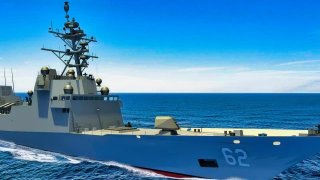The Navy’s New Constellation-Class Nightmare Is Now Unfolding
The U.S. Navy's new Constellation-class frigate has faced a significant cost overrun, with expenses underestimated by 40%. Initially aimed to be a cost-effective and interoperable vessel, the project now suffers from incomplete design elements and unexpected weight growth.
Summary and Key Points: The U.S. Navy's new Constellation-class frigate has faced a significant cost overrun, with expenses underestimated by 40%. Initially aimed to be a cost-effective and interoperable vessel, the project now suffers from incomplete design elements and unexpected weight growth.

-Despite efforts to partner with Italian shipbuilder Fincantieri for increased interoperability, changes have reduced this from 85% to just 15%. Both the Biden Administration and the Navy face criticism for the mishandling of the program, reflecting broader issues in defense procurement.
-The final cost of the frigate is expected to be around $1.6 billion, significantly higher than initially planned.
Navy’s Constellation-Class Frigate Cost Overruns: A 40% Miscalculation"
In classic Pentagon fashion, the bean counters and eggheads in the Navy “underestimated the price tag of [the Constellation-class frigate] by 40 percent.”
This, at a time when most Americans are struggling to pay for groceries and the US government’s debt interest payments are now outstripping its elephantine defense budget.
Now, the Navy, which has been on a spending spree, has miscalculated the cost of its new frigate. Not by five or ten percent. But by 40 percent! If a private corporation miscalculated their budget for a project by 40 percent, people would have their careers ruined and it might actually take that company down.
But it’s just another rounding error for the Pentagon and defense industrial base that already receives far too much money and delivers far less than they promised!
The U.S. Navy Just Wastes Our Money These Days
It appears that the Navy jumped the gun with their creation of the Constellation-class next-generation guided-missile frigate.
According to USNI News, the Navy approved the design and development of the Constellationwith “incomplete elements of the ship design—including information gaps related to structural, piping, ventilation, and other systems—and underestimation of adapting a foreign design to meet Navy requirements.” These developments, in turn, has led to what the Navy is euphemistically referring to as “unplanned weight growth.”
In other words, the new Constellation-class now has a big design, causing all sorts of complications for the boat as the Navy moves forward with its development.
The problem redounds to the fact that the Navy has partnered with an Italian defense contractor, Fincantieri Marinette Marine, which is also responsible for the construction of several major European warships as well as building the Saudi multi-mission surface combatant to the Constellation-class and the US Navy’s disastrous Littoral Combat Ship (LCS). Despite having incomplete elements of the ship design, the Navy told Fincantieri to start cutting steel for the Constellation-class.
Of course, only after the steel was cut did the Navy realize that they had erred. The whole point of building the Constellation with an Italian shipbuilder was to increase interoperability with allied navies as well as to decrease the overall cost. Well, now that the Navy so badly miscalculated the design requirements for the boat in question, there goes the cost-effective bit (interesting how that’s always the first thing sacrificed in these projects, no?)

In the specific case of the Constellation-class, partnering with Fincantieri was meant to allow for an 85 percent interoperability with the Italian shipbuilder’s FREMM-class frigate that many European navies use. Because of all the design changes the Navy insisted upon, the Constellation-class now has only a 15 percent interoperability rating with the European warships.
Politicians Point the Finger
With extreme egg on their face, the Biden Administration’s Navy Secretary Carlos Del Toro actually tried to blame both the Italian shipbuilder and the Trump Administration. In an election year in which the forty-sixth president, Del Toro’s boss, is struggling, the last thing they need is to be blamed for their obvious lack of oversight on this project. But don’t fall for the rhetoric. This is a major mess up by the Biden Administration.
What’s more, Fincantieri did nothing wrong.
Every contractor for the Defense Department underbids and overpromises. This is a matter of “don’t hate the player, hate the game.” It’s just that Fincantieri is a foreign contractor so it’s an easy target for a Biden Administration that is desperate to deflect blame.
The true price of the Constellation-class is going to be closer to $1.6 billion, 40 percent more than what was initially planned for. But for all the accusations made against Fincantieri and the Trump Administration, everyone knows that it was the Navy’s own onerous (and exclusionary) “511 functional design documents,” that even the Government Accountability Office (GAO) has recommended be seriously amended to better comport with cost-save measures in the long-run.
The Navy is to Blame Even More Than the Politicians Are
If there is any group other than the Biden Administration that should be blamed for allowing such a cluster-you-know-what, it is the Navy itself. Indeed, the GAO recommendations made to improve Navy acquisitions as well as to prevent this type of disaster from unfolding again were not political. They were bureaucratic. And, of course, the Navy is trying to deflect as much as the Biden Administration.
Of the five major recommendations the GAO made to make the Navy’s 511 functional design requirementsless rigid, the Navy accepted four—begrudgingly— but balked about the fifth, which called for the Navy to update its testing practices.
The bottom line is that the Defense Department is stuck in the past. The way that they purchase, design, and build equipment is not reflective anymore of the ever-changing realities of modern warfare.
Nor are they mindful (or respectful) of the fact that they are handling billions of tax dollars, taken from the paychecks of hard-working Americans who are increasingly under economic strain. If the Navy believes they need the systems in question (they actually don’t), they should take care to manage the program better and keep costs down as much as possible.
About the Author
Brandon J. Weichert, a National Interest national security analyst, is a former Congressional staffer and geopolitical analyst who is a contributor at The Washington Times, the Asia Times, and The-Pipeline. He is the author of Winning Space: How America Remains a Superpower, Biohacked: China’s Race to Control Life, and The Shadow War: Iran’s Quest for Supremacy. His next book, A Disaster of Our Own Making: How the West Lost Ukraine, is due October 22 from Encounter Books. Weichert can be followed via Twitter @WeTheBrandon.
All images are Creative Commons.


